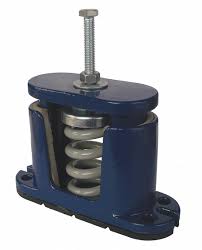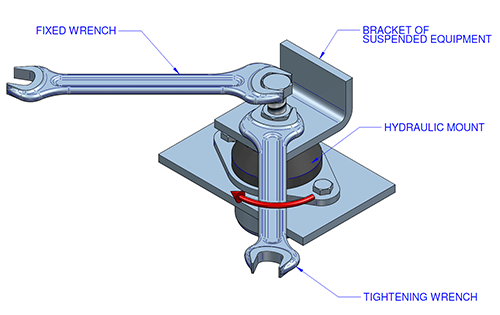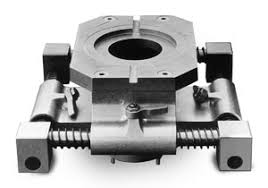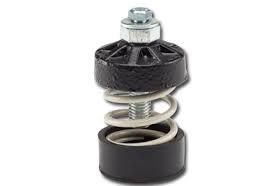Vibration isolation systems are an essential component in maximizing the performance of various mechanical and electronic systems. These systems are designed to reduce the transmission of vibrations from one component to another, thereby minimizing the potential for damage or disruption to sensitive equipment. spring floor mount vibration isolator By implementing effective vibration isolation systems, businesses can ensure the smooth operation and longevity of their machinery, ultimately improving overall performance and reducing maintenance costs. In this article, we will explore the importance of vibration isolation systems and how they can be optimized to enhance performance in a range of industrial and commercial applications.
Vibration isolation systems are used vibration isolation mount to minimize the transmission of vibration from a source to its surroundings, in order to maximize the performance of sensitive equipment or processes. These systems typically involve the use of isolation mounts or pads that absorb and dampen the vibrational energy, preventing it from affecting nearby components or structures. By effectively isolating equipment from external vibrations, performance levels can be significantly enhanced, leading to improved accuracy, precision, and overall efficiency. Vibration isolation systems are commonly utilized in industries such as manufacturing, aerospace, automotive, and precision engineering, where precise and consistent performance is essential. These systems can also help to extend the lifespan of equipment by reducing wear and tear caused by excessive vibration. Overall, maximizing performance with vibration isolation systems is crucial for achieving optimal results in various applications.
Vibration isolation systems are implemented to minimize the transmission of vibration from a source to its surroundings, aiming to maximize the performance of sensitive equipment or processes. These systems typically employ isolation mounts or pads to absorb and dampen vibrational energy, preventing it from affecting nearby components or structures. By effectively isolating equipment from external vibrations, performance levels can be significantly enhanced, leading floor vibration isolator to improved accuracy, precision, and overall efficiency. Vibration isolation systems are commonly utilized in industries such as manufacturing, aerospace, automotive, and precision engineering, where precise and consistent performance is essential. These systems can also help to extend the lifespan of equipment by reducing wear and tear caused by excessive vibration. Overall, maximizing performance with vibration isolation systems is crucial for achieving optimal results in various applications.
Understanding the Importance of Vibration Isolation Systems
vibration isolators hvac

Vibration isolation systems are essential in a wide range of applications to protect sensitive equipment from the negative effects of vibrations. These systems work by dissipating, redirecting, or absorbing vibrations, thereby preventing damage and maintaining the accuracy and performance of the equipment. Common applications of vibration isolation systems include industrial machinery, laboratory equipment, sensitive instruments, and electronic devices. By implementing an effective vibration isolation system, businesses can minimize downtime, reduce maintenance costs, and extend the lifespan of their equipment. It is important to understand the specific requirements of the equipment and the environment in order to select the most suitable vibration isolation solution.
The Different Types of Vibration Isolation Systems

Vibration isolation systems can be categorized into several types based on their mechanism and application. Some common types include passive isolation systems, active isolation systems, and hybrid isolation systems. Passive isolation systems use materials like rubber, springs, or air mounts to minimize the transmission of vibration to sensitive equipment. They are relatively simple and cost-effective but may not be as effective in controlling all types of vibration. Active isolation systems, on the other hand, use sensors and actuators to actively counteract incoming vibrations. These systems can provide greater control and are often used in critical applications where precise vibration control is necessary. Hybrid isolation systems combine elements of both passive and active systems to provide a balance of performance and cost-effectiveness. These systems are often used in applications where a high degree of vibration isolation is required, but cost constraints are also a consideration. In addition, there are also specialized isolation systems designed for specific applications such as seismic isolation for buildings and structures, as well as isolation systems for industrial machinery and equipment. Overall, the choice of vibration isolation system depends on the specific requirements of the application, including the level of vibration control needed, cost considerations, and environmental factors.
How Vibration Isolation Systems Improve Equipment Performance

Vibration isolation systems are designed to reduce the transmission of vibration and shock between a piece of equipment and its environment. This can be achieved using various techniques such as using vibration isolators, flexible mounting systems, or damping materials. By implementing these systems, equipment performance can be improved in several ways: 1. Reduced wear and tear: Vibrations can cause accelerated wear and tear on equipment components, leading to increased maintenance and potential breakdowns. By isolating the equipment from vibration, the longevity of the equipment can be increased, leading to cost savings and reduced downtime. 2. Improved accuracy: Precision equipment such as laboratory instruments, measuring devices, and optical systems can be negatively impacted by vibrations, leading to reduced accuracy and reliability. Vibration isolation systems can minimize these effects, resulting in improved performance and more accurate results. 3. Enhanced productivity: Machinery and equipment that are subject to vibrations can experience decreased productivity due to inefficiencies or errors caused by the vibrations. Implementing vibration isolation systems can help to stabilize and improve the overall performance of the equipment, leading to increased productivity and efficiency. 4. Operator comfort and safety: Vibrations can not only impact equipment performance but also the comfort and safety of operators. Excessive vibrations can lead to discomfort, fatigue, and potential health issues for operators. Vibration isolation systems can help create a safer and more comfortable working environment for personnel. Overall, vibration isolation systems play a critical role in enhancing equipment performance, extending the lifespan of equipment, and improving overall productivity in various industrial and commercial applications.
The Role of Vibration Isolation Systems in Occupational Safety

Vibration isolation systems play a critical role in occupational safety by reducing the transmission of vibration and shock to equipment, structures, and ultimately, to workers. These systems are designed to minimize the risk of injury from exposure to harmful levels of vibration, which can lead to conditions such as hand-arm vibration syndrome and whole-body vibration effects. By effectively isolating vibrating machinery and equipment from the surrounding environment, these systems help to protect workers from potential health hazards and ensure a safer and healthier work environment. Additionally, vibration isolation systems can also help to prolong the lifespan of equipment and reduce maintenance costs by minimizing the impact of vibration on machinery. Overall, these systems are a vital component of occupational safety measures for workers who are exposed to high levels of vibration in their daily work activities.
Considerations for Choosing the Right Vibration Isolation System
When choosing the right vibration isolation system, it is important to consider factors such as the frequency and amplitude of the vibrations, the weight and size of the equipment needing isolation, the environment in which the system will be used, and any specific performance requirements. It is also important to consider the maintenance and installation requirements of the system, as well as any budget constraints. Additionally, it is important to work with a reputable and experienced supplier who can provide guidance and support throughout the selection and implementation process.
The Advantages of Using Active Vibration Isolation Systems
Active vibration isolation systems offer several advantages over passive systems. These include the ability to adapt in real-time to changing vibration levels and frequencies, providing a higher level of isolation across a broader range of conditions. Active systems can also be tuned to specific frequencies, allowing for more precise isolation of vibrations. Additionally, active systems can be more compact and lightweight than their passive counterparts, making them ideal for applications where space and weight are at a premium. Overall, the use of active vibration isolation systems can result in improved performance and protection for sensitive equipment and instruments.
Challenges in Implementing Vibration Isolation Systems
Challenges in implementing vibration isolation systems include finding the right balance between cost and performance, as well as ensuring that the system is properly designed and installed to effectively isolate vibrations. Additionally, selecting the appropriate isolation materials and components, as well as addressing any potential sources of vibration, can pose challenges in the implementation process. Furthermore, integrating vibration isolation systems into existing machinery or structures without causing additional issues can also be a complex task. Lastly, ensuring that the vibration isolation system meets industry standards and regulations adds another layer of challenge to the implementation process.
The Future of Vibration Isolation Systems: Innovations and Trends
strong
The future of vibration isolation systems is seeing continual innovations and trends that are shaping the industry. Advanced materials, such as meta-materials and carbon nanotubes, are being integrated into isolation systems to improve their performance and durability. Additionally, there is a growing emphasis on the development of smart isolation systems that can dynamically adapt to changing environmental conditions and vibration frequencies. Furthermore, the integration of machine learning and AI technologies is enabling predictive maintenance and real-time monitoring of vibration isolation systems, enhancing their overall effectiveness. As the demand for precision engineering and vibration control in various industries continues to grow, the future of vibration isolation systems is poised for further advancements and breakthroughs.
In conclusion, Vibration Isolation Systems are essential for maximizing performance in various industries and applications. By effectively reducing the transmission of vibration and noise, these systems help to improve the operational efficiency, accuracy, and longevity of equipment and machinery. Investing in vibration isolation systems is crucial for ensuring optimal performance and minimizing downtime due to vibration-related issues. With their ability to mitigate the negative effects of vibration, these systems play a key role in enhancing productivity and overall performance.
See also
https://www.enidine.com/en-us/products/industrial/vibration-isolationAbout shaimaa yosef
Hi, My Name is Hafeez. I am a webdesigner, blogspot developer and UI designer. I am a certified Themeforest top contributor and popular at JavaScript engineers. We have a team of professinal programmers, developers work together and make unique blogger templates.


